Soaring Free: Freeware Gliders for MSFS 2020
- Caio "Hueman" Barreto

- Aug 9
- 13 min read
Updated: Sep 9
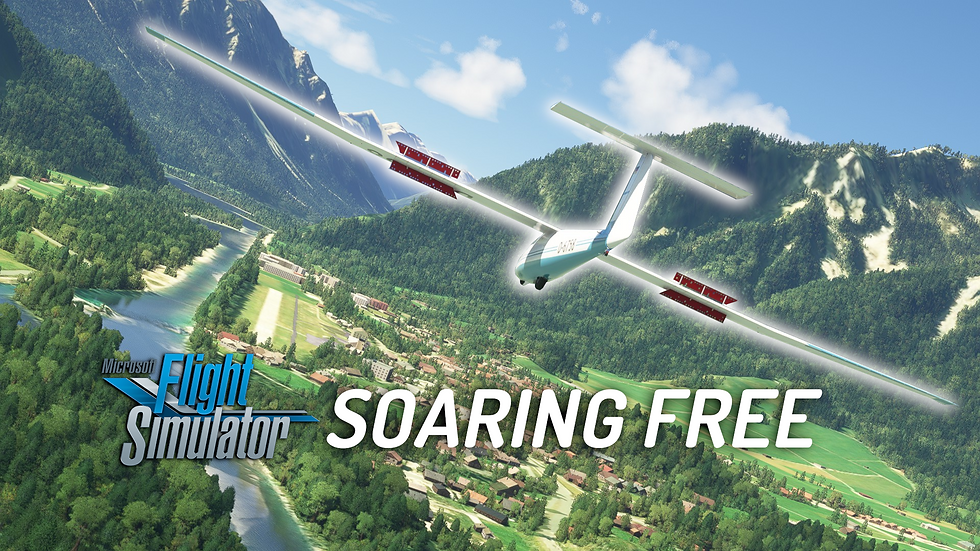
When Sim Update 11 launched for MSFS 2020, it brought one feature to the table which made it unique compared to previous Microsoft Flight Simulator installments: Soaring.
True, there was nothing stopping you from flying a glider in FSX, but MSFS 2020 now had all of the building blocks to really support them: tow planes, winch launches, and the modelling of thermals all created an ecosystem in which sailplanes could truly shine.
It will come as no surprise to long-time readers that we are big fans of unpowered airplanes with really long wings, and that we’re definitely biased when we say soaring in MSFS is an incredibly fun experience you should try out if you haven’t already, but there’s a problem with it: The selection of sailplanes in the base game is rather limited, with only two models to choose from.
Both options are also very modern, high-performance sailplanes - which isn’t a bad thing, but if you want something more old school, it leaves that itch unscratched.
One day, while looking for new aircraft to try out in MSFS, I came across a really good-looking model of an old Polish sailplane on flightsim.to - and it was free. To my surprise, I discovered an entire section of freeware gliders on that website!
We’ve decided to try a number of these freeware gliders out and share our thoughts on them - and hopefully get you to try some of them out yourself!
SZD-30 Pirat
By Yanosik

This Polish single-seat glider from the 1960’s features a unique mixed construction, being built mostly out of wood but with a fiberglass nose section. It’s not exactly high performance by today’s standards but still boasts a rather respectable glide ratio of 33, plenty enough to have some fun cross-country flights in MSFS.
The first thing which caught my eye on this was the external model - I wasn’t expecting a freeware mod to look this good. Everything from the quality of the 3D model to the details and specular maps on the texture just looks right.
The only thing that’s lacking in the external model is a pilot, which makes the aircraft look like a “ghost ship” from certain angles in external view; but this is, of course, a minor nitpick which by no means detracts from the incredible work which has been put in this model. Take a look at how the wing looks under reflection:

The cockpit is likewise very nicely modelled, down to the reliefs in the internal walls - I’d risk saying it has the best modelling and textures out of all cockpits on this list. True, the textures are a bit flat in some places, but for something you’re getting for free it’s downright amazing. The attention to detail shown here is commendable.

As you get acquainted with the SZD-30’s exquisitely modelled office, you’ll notice a very simple, easy-to-read instrument cluster: airspeed, altitude, slip indicator, magnetic compass, and two variometers, one “standard”, vertical velocity indicator vario, and one Total Energy Compensation vario.
Commenting on the accuracy of the flight model is beyond the scope of this article, as I have (sadly) no experience flying an SZD-30; but what I can say is that this mod is definitely fun to fly in MSFS, and apart from a strange tendency to pitch up right after takeoff, the flight model generally behaves as you’d expect from a glider.
This is the aircraft which first brought our attention to the existence of freeware gliders for MSFS, and it did not disappoint. The fact we ended up writing this article should tell you all you need to know!

Schleicher K7 Rhönadler
By GlideSimmer67

Devised by legendary sailplane designer Rudolf Kaiser, this old-school, two-seat training glider is a classic of the post-war gliding scene.
Being from the 1950’s, an era before fiberglass fuselages were commonplace, the K7 is built in the old-fashioned way: steel tubes, wood, and fabric. Widely successful and exported worldwide, at the time of its introduction this was arguably one of the best performing two-seat sailplanes in the world.

The 3D model very nicely represents the aircraft’s tubular steel frame structure, and while it’s a bit low-poly and the textures are flat in some places, in my opinion it still looks really good. The wooden instrument panel, typical of German gliders of the era, adds a touch of charm.
The instrument cluster is simple, but it’s got everything you need - airspeed, altitude, a magnetic compass, turn and bank indicator, and two variometers, with one being a total energy compensation vario.

Externally, just like with the SZD-30, the lack of a pilot model can make it look a bit uncanny from certain angles - but that is, again, a very minor nitpick.
This add-on has been consistently updated since its release, with the mod’s author tweaking flight model values to make it as accurate as possible.
The combination of the unique, vintage look of the aircraft’s steel frame structure from the cockpit, beautifully replicated in this model; the docile, trainer-like handling; and the aircraft’s performance, more challenging than modern gliders but still plenty enough for basic aerobatics, make this freeware mod an absolute joy to fly, and probably the one I’ve had the most fun with on this list.

Slingsby T.31 Tandem Tutor
By Klem

Designed just after WWII, the T.31 (or Cadet Mk. III) was designed as an affordable training glider to teach the young cadets of Britain’s Air Training Corps the basics of flight.
However, the “affordability” part might have been taken a bit too far by Slingsby engineers: with an abysmal glide ratio of 18.5 (less than the side-by-side T.21B!), it's no wonder the Cadet Mk. III was referred to as the “Brick” by the cadets who flew it.But let’s be honest here - we’re plane nerds, and this is the stuff we’re here for.
This MSFS representation beautifully reflects these less endearing attributes of the Tandem Tutor: it soars like a brick alright, and should you elect to use a tow plane for takeoff, make sure it’s in an airfield with low elevation and in a cold day; The game’s default tow plane (Cessna 172) struggles to pull the draggy Slingsby along, and under some conditions it might not be able to take off at all (a behavior which is likely a bit exaggerated).

In terms of looks, while the external model looks decent, the internal cockpit model and textures leave something to be desired - but remember, you’re getting this for free!

Besides, this made me fly the aircraft in external view more often, which is a great way to appreciate this unique aircraft. It is the only sailplane on this list with an open cockpit, and it’s a nice change of pace to fly such an old-school “ab-initio” glider in MSFS.
The Slingsby Type 31 isn’t the sexiest glider out there, and it’s definitely not the best performing, but it’s a classic which was the very first contact with aviation for many - former cadets across the UK fondly remember the “Brick” as the aircraft they first soloed in. If you’re interested in this “seat-of-your-pants” era of aviation, definitely check this one out!
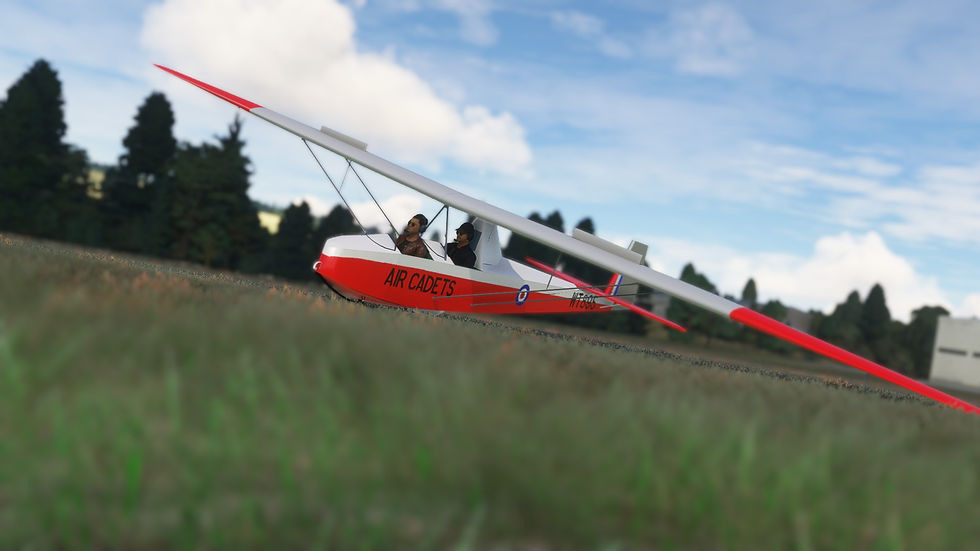
Rolladen-Schneider LS4
By MADoloSimulations

The favorite of many a soaring club and one of the most produced gliders of all time, with over a thousand built, the LS4 owes its longevity to a remarkable combination of high performance and docile, beginner-friendly handling.
This sleek single-seat, glass-reinforced plastic design was one of the aircraft which set the standard for sailplane design and performance in the 1980’s.
How well does this freeware mod represent such a legendary aircraft? Well, as this happens to be the first of three entries by MADoloSimulations on this list, let’s take a moment to address a common trait between all of their gliders: The quality of their work is downright incredible for a freeware product.
Nearly everything, from the attention to detail in the external 3D models to the cockpit functionality, leaves nothing to be desired in comparison to payware modules. The only area where they noticeably fall behind are the internal models and textures for the cockpit - but that's in comparison to paid alternatives, and even then, they’re more than good enough.

There’s custom animations for dumping ballast, a custom navigation computer display which integrates rather nicely with the route manager in MSFS 2020; and since these traits are all shared among all three MADoloSimulations mods we’ll be covering in this article, from now on we’ll be focusing on the additional or unique features which set them apart.
As for the LS4 specifically, this model comes with a very interesting instrument cluster: apart from the small navigation display in the center, all instruments are analog, but with digital readouts for airspeed, altitude and the vario. I’ve found it to be an intuitive combination which adds to the experience of flying this beautifully crafted mod.

My only complaint about this add-on is the fact that the pilot model stays on in cockpit view, which sometimes causes weird visual effects as you can get “inside” the pilot model when using head tracking. Apart from this very minor drawback, this bird is an absolute pleasure to fly, and one we certainly recommend checking out.

Jonkers JS-3 Rapture
By MADolo Simulations

Jonker Sailplanes is a curious case: they’re one of the very few manufacturers of high-performance sailplanes outside of Europe - and arguably the only one in the southern hemisphere as of the time of writing: as much as I’d like to talk about the KW-1b Quero-Quero or the EMB 400 Urupema, they’re not exactly high-performance by today’s standards, and being positively jurassic, have long been out of production.
Built in Potchefstroom, South Africa, Jonker’s sailplanes have been flown to victory in several international competitions: the JS-3 in particular has the 2022 World Gliding Championship and three Women’s World Gliding Championships - 2020, 2022 and 2023 - under its belt, all in the 18-meter class.

Speaking of which, this mod comes in two flavors - one with 15-meter wings (Standard class), and the other in the 18-meter configuration (18-meter class). Just like with the previous MADolo Simulations entry, the overall quality of this add-on is very impressive for something you get for free.
The big novelty in comparison to the previous MADolo entry is the flight computer - with a massive display taking up most of the instrument panel's real estate, this feature will be familiar to those used to MSFS 2020's base game DG-1001E Neo.

Far from being a mere replica of the base game's features though, this add-on's implementation is far more powerful and complete - it can even keep track of the glider's total energy variation over time and plot it on a display so you can visualize the thermals you've found along the way! It was very surprising to see such a system implemented from scratch in a freeware module.
Apart from the center display, this aircraft features a complete set of flight instruments - including a digital ADI and HSI, the latter doubling as a trim indicator.
If you enjoy gliding in MSFS but don't want to give up your digital displays, and you're looking for a high-performance sailplane with state-of-the-art flight instruments - then this add-on is the one for you!

Schleicher AS 33 Me
By MADolo Simulations

As of the time of writing, the Schleicher AS 33 is one of the most modern and high-performance sailplanes in the world; with a glide ratio of 56 when in 18-meter wingspan configuration, its performance is rivalled only by the very best 18-meter class gliders, and clearly exceeded only by those in the Open class.
The AS 33 Me is a self-launching variant, boasting a 35 kW electric motor mounted in a retractable frame. As is typical with high-performance powered sailplanes, the motor and propeller fully retract into the fuselage when not in use.

Its MSFS representation by MADolo simulations is just as complete as their previous entries; it's got the same digital flight computer as their JS-3, with the same features as described previously. The other flight instruments are also the same, with one notable exception: the airspeed indicator.
MADolo modelled a digital airspeed indicator for the AS 33 Me, and while it takes getting some used to (especially if you're a steam gauge appreciator), it must be said that it's a rather convenient piece of kit: the colored V-speed arcs automatically adjust based on conditions such as altitude and air temperature, and it even features an overspeed warning should you end up being over-enthusiastic on a dive.

There's also a gear position indicator, as well as a flap position indicator - a very helpful addition since you have a grand total of 8 different flap settings.
My only complaint about this module is that the engine control/display unit at the bottom of the instrument panel seems rather flat looking, and not up to the same standard of quality present in every other part of the cockpit. However, the only thing this will have any impact on is the eye candy factor of your screenshots; the display gives you all the information you need, and the controls are intuitive and clearly labelled.
This is by far the most feature-rich out of all freeware gliders add-ons we've tried out. It's got it all: self-launch capability with a deployable motor, a digital flight computer, fully functioning ballast system. One might even say it detracts from the fun of soaring by making it too easy; but what's beyond doubt is that to have such an uncompromising collection of features in a freeware product is truly remarkable.
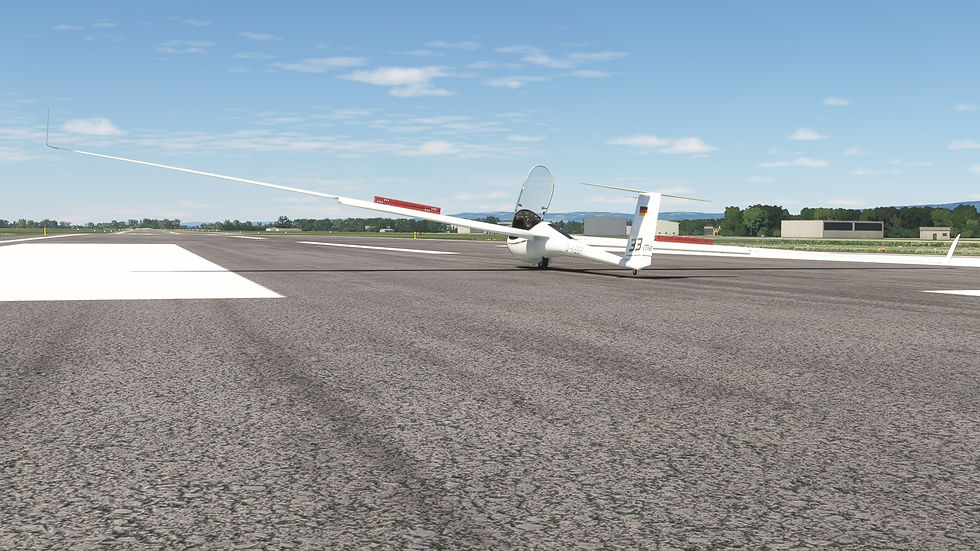
So, just how good are they?
One of the questions which will inevitably come up when looking at freeware models is how well do they compare to their paid counterparts. While one could argue such a comparison is fundamentally flawed - you are, after all, getting one of them for free - it’s still an interesting exercise, if only for curiosity's sake.
It just so happens that Got Friends, an add-on developer specializing in aircraft for MSFS, has a payware AS 33 Me, the exact same model of the last entry in the freeware add-on list above. Faced with such an opportunity - and such a perfect excuse to try this add-on out - we decided to buy this add-on so we could compare both versions.
Right off the bat, an area where Got Friends’ model immediately stands out is the visuals. The 3D model and the textures are absolutely immaculate - and while you could say the freeware’s external model comes close, once you look at the cockpit the difference is staggering. The textures, and particularly details such as the engine’s display in the lower part of the instrument panel, look much better.
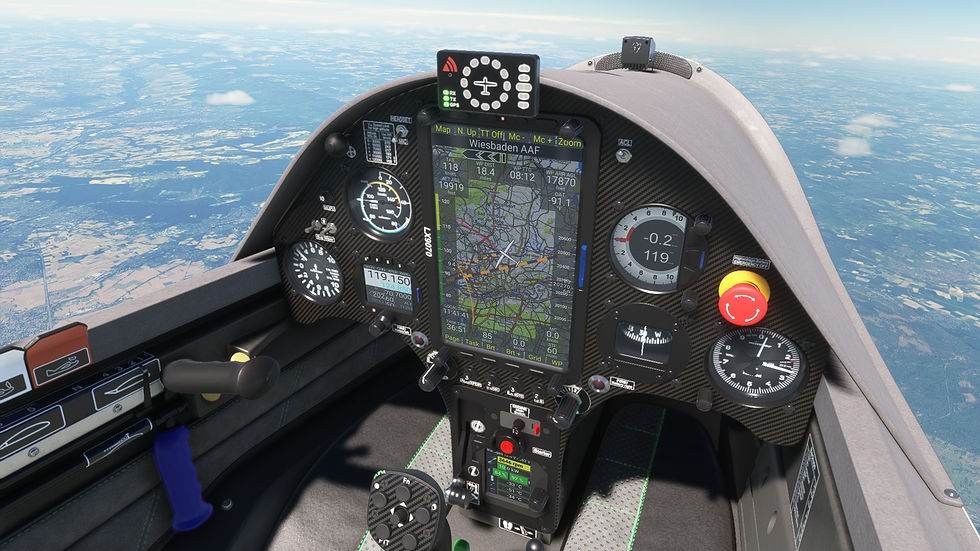
Another area which Got-Friends has modelled with painstaking attention to detail is the AS 33 Me's electric motor. You could argue they went too far with the internals, but in this case you’re paying for it, so the extra quality is definitely appreciated.

But looks alone do not a good module make; so let’s take a look at the functionalities.
One of the main perks of the Got-Friends AS 33 is that it includes new launch options, including a bespoke tow plane - the PZL-104 Wilga 35A, which you can then use for any other gliders you own as well.
A neat feature is that you can adjust the placement of the instrument gauges to your heart's content. Surprisingly, they're more analog than the ones in the freeware version; for instance, the airspeed indicator, which is digital in the MADolo Simulations model, is instead an analog gauge in the Got-Friends model. This isn’t a good or a bad thing; just an interesting difference to keep in mind.
As for the piece of hardware taking up most of your instrument panel, the massive LX9070 flight computer display in the center offers the same features as the one in the freeware version, with a few minor differences.
And last but not least, the Got-Friends AS 33 comes with a fully functioning FLARM! While it doesn’t really add much to the gameplay experience outside of multiplayer, it’s a nice novelty to have and shows how much effort the developers put into paying attention to every detail.
A necessary disclaimer is that I’ve never flown an AS 33, nor any of the other sailplanes showcased here (a shortcoming I’m happily willing to remedy, in case the reader has access to such machines), and therefore I cannot comment on the accuracy of the flight model; but qualitatively, the Got-Friends version does feel nicer in subtle ways, with a smoother response to control inputs. This does not detract from the freeware model, which still feels great to fly.
As far as the external model goes, the quality of the freeware model (left) is remarkably similar to that of the payware one (right)
The most striking difference is the modelling of the moment arm of the engine’s thrust in relation to CG in the Got-Friends version; if you carelessly push the throttle forward too fast upon deploying the engine, you will be greeted by an expeditious pitch down as Newton reminds you that your propeller is sitting at the end of a really long arm, way above the fuselage.
Overall, while the payware add-on is clearly better as expected, the difference isn’t massive - the only truly noticeable difference is in the visual arena, especially the internal cockpit model. In terms of functionality, both are extremely close, with the freeware option offering the same features as the paid one.
What this paid option really gets you, apart from the improved visuals, is an extra layer of refinement: it has the same features, but with a higher level of quality in their implementation.
The differences are mostly apparent in details, such as the water ballast effects: MADolo on the left, Got-Friends on the right
This is great news for the player, as you can try out MADolo Simulations’ freeware AS 33 and see if you enjoy flying it around - and if you do, and decide you want to take it to the next level, then you can confidently go for Got-Friends’ expertly crafted payware model knowing you won’t regret your purchase.
So, to answer the question posed earlier: Yes, the freeware options are really, really good! In this case we've looked at, both models - freeware and payware - are very impressive. Naturally, Got-Friend's version will give you a higher level of fidelity; but most remarkably, in terms of functionalities MADolo's free module is just as complete as any paid option.
Conclusions

My initial expectation when first stumbling into the world of freeware gliders for MSFS was that they'd be at most a fun change of pace. What I found instead was a series of surprisingly high-quality models which have nothing to be ashamed of in comparison to Asobo's base game assets - and in certain areas, even surpass them.
As anyone who's ever worked with implementing an aircraft into a game will tell you, this takes a lot of time and effort. 3D modelling, texturing, coding, finding sources for flight parameters - none of these are things we should take for granted. The fact we're able to enjoy these aircraft for no cost is the result of a true labor of love by their developers, born out of a desire to share their passion for flight simulation - and their favorite gliders - with as many people as possible.
This unsung, selfless effort is truly commendable, and well deserving of your attention. If you have Microsoft Flight Simulator 2020 and enjoy gliding, we strongly encourage you to check these add-ons out - it’s the best soaring you can have for free!
About the Writer

An incurable aviation fanatic since childhood, fascinated by the design and history of practically anything that flies. A long-time fan of flight games, he holds a bachelor's degree in aeronautical engineering and pursues his hobbies of drawing, writing and flight simulation on his spare time. See Staff Profile.









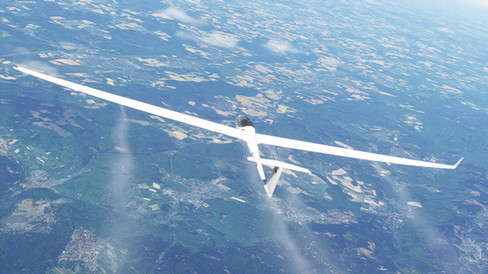



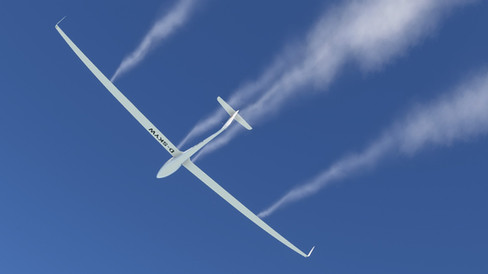

























.png)